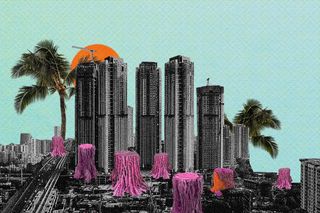
India Wants to Build Smart Cities. We Asked Experts if These Urban Designs Can Survive the Climate Crisis.
“The vision of the Smart City Mission comes at the cost of the ecological landscape of cities and ideas of inclusivity.”

We live in cities of volatility. Heat waves sweep across parts in a blanket of red and orange, just as easily as devastating floods halt life and livelihood. Droughts, locusts, and natural disasters are becoming frequent and fierce; leaving a city, and its people, to respond to climate crises.
Seven years ago, India decided to make concerted efforts to make its cities smart and sustainable. The SMART City Mission created an aspirational vision of a city with tall buildings, steel glasses, and concrete walkways. But embedded within these plans was a dissonance between planning objects and climate change realities: attempts of beautification failed to account for rising temperatures and depleting forest cover. By one estimate, 90% of the buildings under construction today pay little attention to India’s climate—locking in increased heat risk for decades to come, which would worsen the way millions of people experience heat.
Just how resilient are Indian cities to the climate crisis? And how do we reimagine the framework within which we think of our cities? To understand this, The Swaddle’s Saumya Kalia spoke to Seema Mundoli, an urban cities researcher at Azim Premji University who researches aspects of urban sustainability; Chitra Vishwanath, a Bengaluru-based architect who weaves ecology into her designs; and Chennai-based Benny Kuriakose who works at the intersection of architecture and conservation.
The Swaddle: What does it mean for a city to be climate resilient?
Chitra Vishwanath: The most popular answer to this question is that the city is climate-resilient when it can absorb future shocks. To us, in India, added input will be that the city absorbs the shocks with equity and empathy in place. Urban India will house 40% of the Indian population by 2030. So while cities are vehicles for prosperity, they also foster deep inequality. Climate shocks will exacerbate the inequalities since the land and access to water will be highly contested resources.
Seema Mundoli: At present, whenever there is an unprecedented event like an urban flood or a drought, which have both been happening with increasing frequency across cities in India, there is a complete collapse of all services and infrastructure. There are also lasting impacts of floods in terms of property destroyed and lives lost, with more vulnerable sections often being the worst affected. The resilience of cities to me, then, is the ability to both absorb these kinds of shocks but at the same time develop some form of adaptation that will be useful in the long term.
For example, say in the case of the Chennai floods of 2015, and the severe water scarcity in 2019 … the crux of both the problems lies in how the city has treated its water bodies and wetlands.
Protecting this blue infrastructure can ensure that floods are not as severe as before with the wetlands soaking in excess rain, and also replenishing groundwater at the same time. The worst affected by either floods or water scarcity are informal settlements. So, any action to build resilience will have to use their experiences, knowledge, and impacts suffered as the baseline.
TS: Is India’s architecture prepared to deal with extreme weather conditions, like heat waves and floods? Why or why not?
Benny Kuriakose: Disasters are on the increase. We think about disasters only when it comes and we give importance to relief measures. But to become resilient means we need more long-term planning, which is missing in our present circumstances; what we need is plans which will provide long-term benefits. It is during the last century that the thinking developed, by which we need not design according to the climate since we can do air-conditioning, etc. We were trying to emulate the West because we thought that what they are doing is correct. But now it is very clear that this is adding oil to the burning climate change issue.
CV: In 2013, Ahmedabad floated the Heat Action Plan. This was felt to be a necessity after the experience of the summer of 2010: 1,000 people died in one month and 100 neonatal deaths occurred in a day. The city took notice of this and developed a plan. The plan has had its successes and has also been followed up by other states and cities in the country, but it is largely a medical advisory and does not take into account city planning.
The architecture of buildings per se is a small player – the larger being the architecture of the city planning itself. City planning needs to be based on the sun path. In most cities of India, we need shade at the level of pedestrian movement, while we need the sun to harvest energy. Building glass facades do not absorb ultraviolet rays to the interior but reflect it back to the outside, further harming the environment. This calls for regulating building facades so that they do not contribute to the urban heat island effect [when the temperature is higher in an area or region than in the surrounding]. Overall, this is a scenario where the comfort of the inside is at the cost of discomfort outside. At the moment obfuscated by-laws based on economic considerations are promulgated and not ecological sense. This has to change and change fast. The top-down approach needs to change and through decentralization decisions on eco-systems should be taken.
There needs to be a paradigm shift in the way we think of nature in cities in our urban plans—not as an “also needed” for cities, but as being the core of making cities climate-friendly.
SM: While traditional materials for housing may be more climate-friendly, they will not be able to support the scale of urbanization projected. Cities will still need high rises built with concrete and other such construction material that may not be the best in terms of protecting from heat waves or floods. I do feel that the problem is not just with the material used for construction; it is where the construction has happened—over a lake, a wetland, and so on. So, more importantly, the focus should be on overall city design – what are we doing away with in urban plans, that ends up exacerbating heat waves or floods? The answer is simple – the green, blue, and open spaces that are critical for maintaining the microclimate of cities.
TS: Our current urban planning banks on the Smart Cities Mission. What is lost/gained with this objective?
[The government of India has spent more than Rs. 2 crores in building 5,151 projects across 100 cities. It was launched in June 2015, with the objective of making cities sustainable and preparing for extreme weather conditions.]
CV: Let’s understand SMART in its mnemonic sense. SMART is an acronym that stands for Specific, Measurable, Achievable, Realistic, and Timely. But SMART Cities are not yet taking cognizance of ecology in its fold. They… are placing underground cables, making beautiful (ostensibly in some minds) parking, and undertaking some restoration projects. The tall steel and glass objects are aspirations of the people with poor vision and imagination. We are suffering because of such implementation.
SM: Frankly, it [the scheme] is anything but smart! The vision of the Smart Cities Mission (SCM) comes at the cost of the ecological landscape of cities and ideas of inclusivity. Take any city in the SCM, you will see that there is an emphasis on beautification that extends to parks, waterfronts, lakes, and so on. This beautification is leading to two things—one is more concretization of the already limited natural spaces in the cities and also, even worse, the exclusion of local communities who used these spaces traditionally. [Out of the seven smart cities in Bengaluru], each one of them has ecological and social justice concerns, be it the plans for Cubbon Park in Bengaluru or the waterfront along the Tungabhadra river in Shimoga. We are gaining the false promise of infrastructure and services and losing out on the critical ecological services while making spaces in cities more unequal.
BK: Unfortunately, creating modern skyscrapers in our cities is being equated to development. We have to look at the long-term benefits. This is where many of our projects fail. What we need is not blind development. What is absolutely required can be done. Neglecting our historic cities and creating glass buildings that can go anywhere is not smart growth.
TS: How does a city’s infrastructure impact people’s experiences of extreme weather?
CV: Heat and flooding are two extreme conditions Indian cities will face. Architecture has a huge part to play to mitigate and make the buildings resilient to these shocks. But, they end up adding to the heat island and urban flooding of the city while making the work/living spaces cooler and safe. Architecture has to deal with the contradiction placed by urban planning – it is in a rather tough situation. For example, if the city keeps digging its roads because it has not planned its infrastructure in a comprehensive manner, or vested interests do a bad job on the roads, the buildings have to adopt noiseless and cool interiors. Glass and air-conditioning then become the answer. If by-laws prioritize density, obviously open spaces and trees are sacrificed in the greed to achieve higher saleable areas. A lack of reliable public transportation and dependencies on personal vehicles further lead to air/noise pollution and congestion. Slum Rehabilitation is done with badly ventilated and congested buildings which leads to poor investing heavily in energy-intensive ACs and also suffering bad health.
Architecture alone cannot be a villain; we need an enlightened ecosystem-based approach. The heat and climate action plans need to become granular and be part of the by-laws.
SM: The kind of infrastructure and architecture in cities does affect the temperature in cities. But considering the scale of urbanization … we are left with few options when it comes to the choice of materials for infrastructure. But what we do have a choice about is how we can design to reduce dependence on air conditioners and other high-carbon-footprint technologies, go for more natural ventilation and, of course, protect as well as enhance the existing green spaces in cities.
BK: This is explained through the well-researched phenomenon of the “heat island effect.” The temperature can go up by 3 degrees or even more in certain areas of the city. The fusion of modern techniques with traditional ideas is what we have been trying to perfect over the years. The wide regional variations within a state in India are something we must learn to appreciate and learn from, and adapt to our contemporary ways of life. We recognize that varied materials, climate, and culture in India are sufficient to provide us without varied ways of designing and constructing unique sustainable buildings – we wish to challenge the way the modern construction industry operates.
TS: The latest IPCC report shows how smart urban planning can mitigate the effects of climate change. Why is it important to make architecture more cognizant of climate realities, especially in India?
Today, buildings are responsible for more than 40% of global energy used and as much as one-third of global greenhouse gas emissions, both in developed and developing countries.
CV: I maintain that building decisions are not solely villains here and it is important to look at urban by-laws. But let us discuss buildings – a lot can be attempted here. There are two aspects: construction material and people constructing the buildings. We in India need to build a lot, especially housing and social infrastructures like schools and community spaces. All these need not be towers and they can be built with local materials. We need a local material database with information on the various environmental implications of their use and meaning. These buildings should be a repository of local skills and enhance the same through new learning. Urban migration is one part of the climate crisis … but the underbelly of the infrastructure is the people who make it and much effort should be paid to make construction jobs decent work. Construction work should be safe, healthy, and fair-waged – it is not so today. This keeps the vicious cycle of poverty growing. If we do not address the human issues, the hardware of infrastructure will remain a mirage.
BK: The building industry contributes a significant portion to the global warming crisis. It is very important that the profession realizes this issue. The solution is not to follow the Western models, but to look within us and toward our vernacular architecture. The danger is around the corner and it is important that we act swiftly. We need to look at this now and plan for the changes which might be happening after 50 years.
SM: India is highly vulnerable to climate change, and we should worry because we also have a large population and a large population of vulnerable groups. The magnitude with which a climate event affects the vulnerable is many times more than it does a well-to-do person who has the networks and resources to bounce back. If we do not want climate refugees, we need to ensure that we are able to invest in research and development of infrastructure that increases the resilience of these vulnerable groups. We need a lot more thinking to be done about how urban plans, especially infrastructure, are designed to address climate change impacts. Architecture and civil engineering colleges across the country need to include in their programs courses on climate realities and sustainability challenges.
TS: If development plans were to meet the realities of the climate crisis, what would city infrastructure and planning look like?
SM: This is a tough one. This is a utopia at this point and frankly, at least for me, utopias cannot provide the solution to the climate crises. What we need is dynamic and responsive city planning – from the bottom up, as messy and slow as it may be. We have some broad parameters to guide us and, to me, the most important would be investing in protecting and strengthening natural systems that can possibly be the only buffer against extreme climate events and provide critical services that no built infrastructure can provide.
CV: Cities can be made resilient to a large extent; one way to start will be to understand their ecological services. We need to plan the cities taking into account their hydrology and hydrogeological aspects. When we build over its riparians and valleys, we are inviting floods; even extensive paving of the earth and not allowing for recharge also contributes to flooding. We also need to consider that rainfall patterns are changing; we are experiencing more thunderstorms than the monsoon rains we were used to. So, large volumes of water in a short duration affect the capacity of recharge and transportation of water. While we get heavy rains in a short time, we are going to experience longer summers. Are our cities capable of providing cooler areas to work and live in? One idea is to think about the undergrounds, which tend to be 5-10 degrees cooler than above grounds. They will reduce our dependence on cooling, and the same can also provide materials for construction.
The idea of ecological buildings is taking root. Bengaluru has shown the path; this is a city with 10,000 contemporary earth buildings – globally the largest number. It has incorporated smart water harvesting and water treatment systems within its water and sewerage infrastructure.
It is not that we are not capable of thinking of such ideas or do not have capacities amongst us – but we get carried away by the chest-thumping of a development chimera, and fail to think at all of what is the future being left for our children and grandchildren. Cities are not buildings alone — they are their air, water, and people.
This interview has been edited for clarity and length.
Saumya Kalia is an Associate Editor at The Swaddle. Her journalism and writing explore issues of social justice, digital sub-cultures, media ecosystem, literature, and memory as they cut across socio-cultural periods. You can reach her at @Saumya_Kalia.
Related


An Optical Illusion Can Help Researchers Better Understand Our Brains
